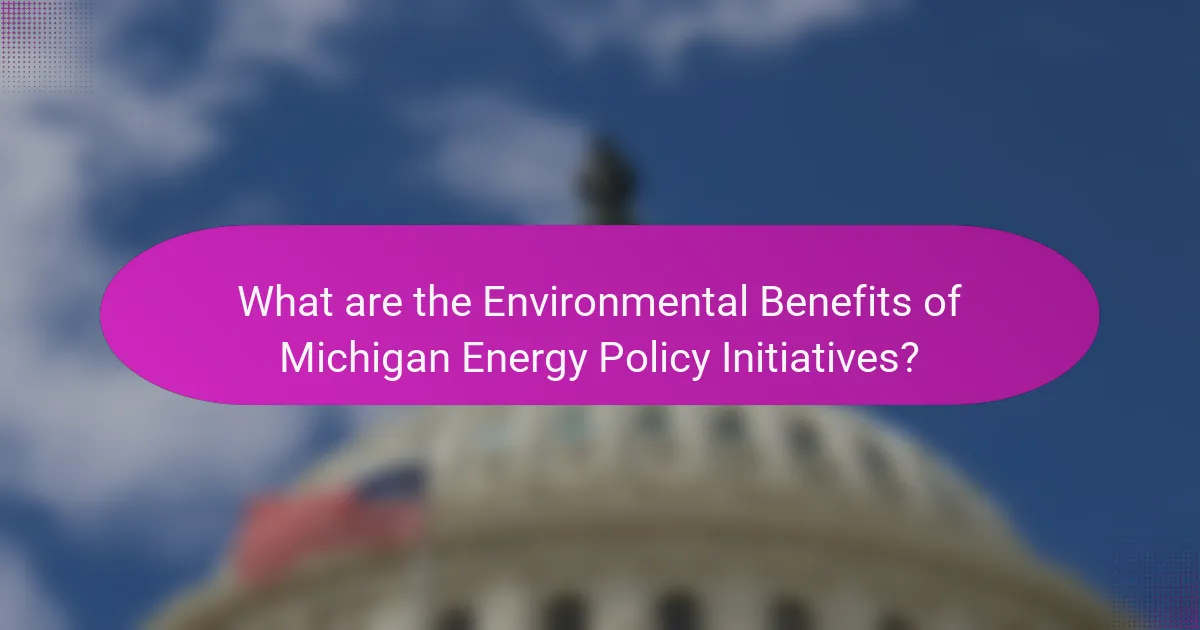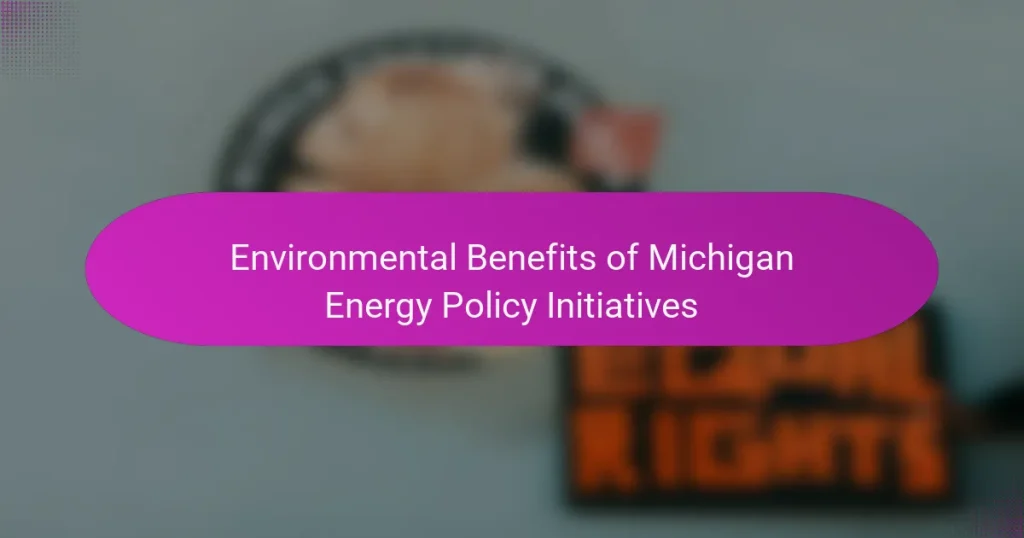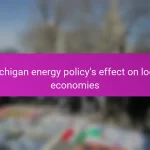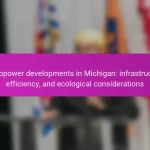
What are the Environmental Benefits of Michigan Energy Policy Initiatives?
Michigan energy policy initiatives provide significant environmental benefits. These initiatives promote the use of renewable energy sources, reducing greenhouse gas emissions. By transitioning to wind, solar, and hydroelectric power, Michigan decreases its reliance on fossil fuels. This shift results in cleaner air and improved public health outcomes. Additionally, energy efficiency programs help lower energy consumption, further minimizing environmental impact. According to the Michigan Department of Environment, Great Lakes, and Energy, these policies aim to achieve a 26% reduction in carbon emissions by 2025. This commitment aligns with broader climate goals and supports sustainable development. Overall, Michigan’s energy policies contribute to a healthier ecosystem and combat climate change effectively.
How do Michigan Energy Policy Initiatives contribute to environmental sustainability?
Michigan Energy Policy Initiatives enhance environmental sustainability through the promotion of renewable energy sources. These initiatives aim to increase the use of wind, solar, and biomass energy. As a result, they reduce reliance on fossil fuels, which are major contributors to greenhouse gas emissions. The state has set targets for achieving 50% renewable energy by 2030. This shift not only lowers carbon emissions but also improves air quality. Furthermore, energy efficiency programs help reduce overall energy consumption. These programs lead to lower energy bills for consumers while minimizing environmental impact. Collectively, these efforts contribute to a more sustainable energy future for Michigan.
What specific policies are in place to promote renewable energy?
Michigan has implemented several specific policies to promote renewable energy. The state’s Renewable Portfolio Standard (RPS) mandates that utilities obtain 15% of their energy from renewable sources by 2021. The Clean, Renewable, and Efficient Energy Act encourages investment in renewable technologies. Michigan also offers tax incentives for renewable energy projects, such as property tax exemptions and personal property tax exemptions for solar energy systems. The state has established the Michigan Energy Office to support renewable energy development and efficiency programs. Additionally, the state participates in regional initiatives that promote clean energy and greenhouse gas reductions. These policies collectively aim to increase the share of renewable energy in Michigan’s energy mix and reduce environmental impacts.
How do these policies reduce greenhouse gas emissions?
These policies reduce greenhouse gas emissions by promoting renewable energy sources and enhancing energy efficiency. By incentivizing wind, solar, and hydroelectric power, they decrease reliance on fossil fuels. Transitioning to cleaner energy reduces carbon dioxide and methane emissions significantly. Energy efficiency measures, such as upgrading buildings and appliances, lower overall energy consumption. This results in fewer emissions from power plants. According to the Michigan Department of Environment, Great Lakes, and Energy, these initiatives aim to cut emissions by 26% by 2025. Additionally, they encourage sustainable practices in transportation, further minimizing greenhouse gases.
What role does energy efficiency play in Michigan’s environmental initiatives?
Energy efficiency is a key component of Michigan’s environmental initiatives. It reduces energy consumption, leading to lower greenhouse gas emissions. The Michigan Energy Efficiency Program aims to promote sustainable practices. This program encourages businesses and residents to adopt energy-saving technologies. As a result, energy efficiency contributes to cleaner air and water quality. In 2020, energy efficiency measures saved Michigan residents over $1 billion. These savings demonstrate the financial benefits alongside environmental impacts. Overall, energy efficiency plays a crucial role in advancing Michigan’s sustainability goals.
How are energy efficiency programs implemented in Michigan?
Energy efficiency programs in Michigan are implemented through a combination of state regulations and utility initiatives. The Michigan Public Service Commission oversees these programs, ensuring compliance with state laws. Utilities offer various incentives, such as rebates and grants, to encourage residential and commercial energy-saving measures. Programs often include energy audits, which assess energy use and identify efficiency upgrades. Additionally, the state promotes public awareness campaigns to educate consumers on energy conservation. In 2020, Michigan’s energy efficiency programs saved approximately 1.4 billion kilowatt-hours, demonstrating their impact. These efforts align with Michigan’s goal to reduce energy consumption and greenhouse gas emissions.
What are the measurable impacts of these programs on the environment?
The measurable impacts of Michigan’s energy policy initiatives on the environment include reduced greenhouse gas emissions and improved air quality. These programs have led to a decrease in carbon dioxide emissions by approximately 25% since 2005. Renewable energy sources, such as wind and solar, now contribute around 15% of the state’s energy mix. This transition reduces reliance on fossil fuels, which are major contributors to pollution. Additionally, energy efficiency programs have resulted in lower energy consumption, further decreasing environmental strain. The Michigan Department of Environment, Great Lakes, and Energy reports that these initiatives have also enhanced habitat preservation and biodiversity. Overall, the programs demonstrate significant positive outcomes for the environment.
How do Michigan’s energy policies affect local ecosystems?
Michigan’s energy policies significantly impact local ecosystems by promoting renewable energy sources and reducing greenhouse gas emissions. These policies aim to transition from fossil fuels to wind, solar, and hydroelectric power. This shift leads to decreased air and water pollution, benefiting wildlife and plant life. For instance, the Michigan Clean Energy Plan targets a 50% reduction in carbon emissions by 2030. This reduction helps mitigate climate change effects on ecosystems. Additionally, policies that support energy efficiency can lower energy consumption, reducing habitat disruption from energy extraction activities. Overall, Michigan’s commitment to sustainable energy practices fosters healthier local ecosystems.
What measures are taken to protect biodiversity through energy initiatives?
Energy initiatives in Michigan aim to protect biodiversity through various measures. These measures include promoting renewable energy sources like wind and solar. Transitioning to these sources reduces reliance on fossil fuels, which helps decrease habitat destruction. The initiatives also involve implementing energy efficiency programs that lower energy consumption. This reduction in demand can lead to less environmental degradation. Additionally, energy policies encourage the preservation of natural habitats. For example, regulations often require environmental impact assessments for new projects. This ensures that biodiversity is considered in energy planning. Overall, these initiatives are designed to create a balance between energy production and ecological preservation.
How do these policies address water and air quality concerns?
These policies address water and air quality concerns by implementing stricter emissions standards and promoting renewable energy sources. Stricter emissions standards reduce pollutants released into the air. This leads to improved air quality and decreased respiratory health issues. The promotion of renewable energy sources, such as wind and solar, minimizes reliance on fossil fuels. This transition results in lower greenhouse gas emissions and less water contamination from energy production. Additionally, policies encourage water conservation practices, which help protect local water sources. Overall, these initiatives contribute to a healthier environment.
What challenges do Michigan Energy Policy Initiatives face in achieving environmental goals?
Michigan Energy Policy Initiatives face several challenges in achieving environmental goals. One major challenge is the reliance on fossil fuels, which contributes to greenhouse gas emissions. Transitioning to renewable energy sources requires significant investment and infrastructure changes. Regulatory hurdles can slow down the implementation of new technologies. Additionally, public resistance to policy changes can hinder progress. Economic factors, such as the cost of renewable energy, also play a critical role. According to the Michigan Public Service Commission, achieving a 50% renewable energy target by 2030 will require overcoming these obstacles.
How do economic factors impact the implementation of these policies?
Economic factors significantly influence the implementation of environmental policies in Michigan. Budget constraints can limit funding for energy initiatives. High initial costs can deter investment in renewable technologies. Economic growth can increase demand for energy, impacting policy effectiveness. Conversely, strong economic conditions can facilitate funding for green projects. Job creation in renewable sectors can garner public support for policies. Economic incentives can drive adoption of energy-efficient practices. The overall economic climate shapes public and private willingness to engage with energy policies.
What are the public perceptions and attitudes towards these initiatives?
Public perceptions of Michigan energy policy initiatives are generally positive. Many residents recognize the importance of sustainable energy sources. Surveys indicate that a significant majority supports renewable energy development. For example, a 2021 poll found that 70% of Michiganders favor increased investment in solar and wind energy. Additionally, public awareness of climate change drives support for these initiatives. Local communities often express enthusiasm for job creation linked to green energy projects. However, some skepticism exists regarding implementation costs and reliability. Overall, the prevailing attitude leans towards favoring environmentally friendly policies.
What future developments are anticipated for Michigan’s energy policies?
Michigan’s energy policies are anticipated to focus on increasing renewable energy sources and enhancing energy efficiency. The state aims to achieve a 50% reduction in greenhouse gas emissions by 2030. This aligns with the broader goal of transitioning to a carbon-neutral economy by 2050. Additionally, Michigan plans to invest in electric vehicle infrastructure and promote sustainable transportation options. The state is also expected to implement more stringent regulations on fossil fuel usage. Recent legislation supports these initiatives, indicating a strong commitment to environmental sustainability.
How might upcoming legislation enhance environmental benefits?
Upcoming legislation may enhance environmental benefits by promoting renewable energy sources. This shift can lead to reduced greenhouse gas emissions. For instance, transitioning to solar and wind energy can significantly lower carbon footprints. Enhanced regulations may also encourage energy efficiency in buildings and transportation. Improved energy efficiency can decrease overall energy consumption. Furthermore, legislation can provide incentives for sustainable practices among businesses. These incentives may lead to increased investment in green technologies. Overall, such measures can contribute to a healthier ecosystem and improved public health outcomes.
What innovations in technology could support these initiatives?
Innovations in technology that could support Michigan’s energy policy initiatives include renewable energy systems, energy storage solutions, and smart grid technology. Renewable energy systems, such as solar panels and wind turbines, can significantly reduce greenhouse gas emissions. For example, Michigan has increased its wind energy capacity by over 1,000 MW since 2010. Energy storage solutions, like advanced battery systems, enable efficient energy use and grid stability. The growth of energy storage in Michigan is projected to reach 1,500 MW by 2025. Smart grid technology enhances energy efficiency by optimizing electricity distribution and consumption. This technology can reduce energy waste by up to 30%, as evidenced by pilot programs in various Michigan cities. These innovations collectively support the state’s environmental goals by promoting sustainable energy practices.
What best practices can be adopted to maximize the environmental benefits of Michigan Energy Policy Initiatives?
Adopting best practices to maximize the environmental benefits of Michigan Energy Policy Initiatives involves enhancing renewable energy use and improving energy efficiency. Implementing aggressive renewable portfolio standards can increase the share of renewable energy sources in the state’s energy mix. Additionally, promoting energy efficiency programs can lead to reduced energy consumption and lower greenhouse gas emissions.
Encouraging community solar projects allows more residents to participate in renewable energy generation, increasing local acceptance and involvement. Moreover, investing in smart grid technology can optimize energy distribution and reduce waste.
Collaboration with local governments and stakeholders ensures that policies align with community needs and environmental goals. Regular assessments of energy policies can help identify areas for improvement and adapt to new technologies.
According to the Michigan Public Service Commission, these strategies can significantly reduce carbon emissions and enhance sustainability in energy practices.
The main entity of this article is Michigan Energy Policy Initiatives, which focus on promoting renewable energy sources and enhancing energy efficiency to achieve significant environmental benefits. The article outlines how these initiatives contribute to reducing greenhouse gas emissions, improving air and water quality, and supporting local ecosystems. Key policies such as the Renewable Portfolio Standard and various energy efficiency programs are discussed, along with their measurable impacts on carbon emissions and public health. Additionally, the article highlights the challenges faced in implementing these policies and anticipates future developments aimed at furthering Michigan’s commitment to environmental sustainability.


